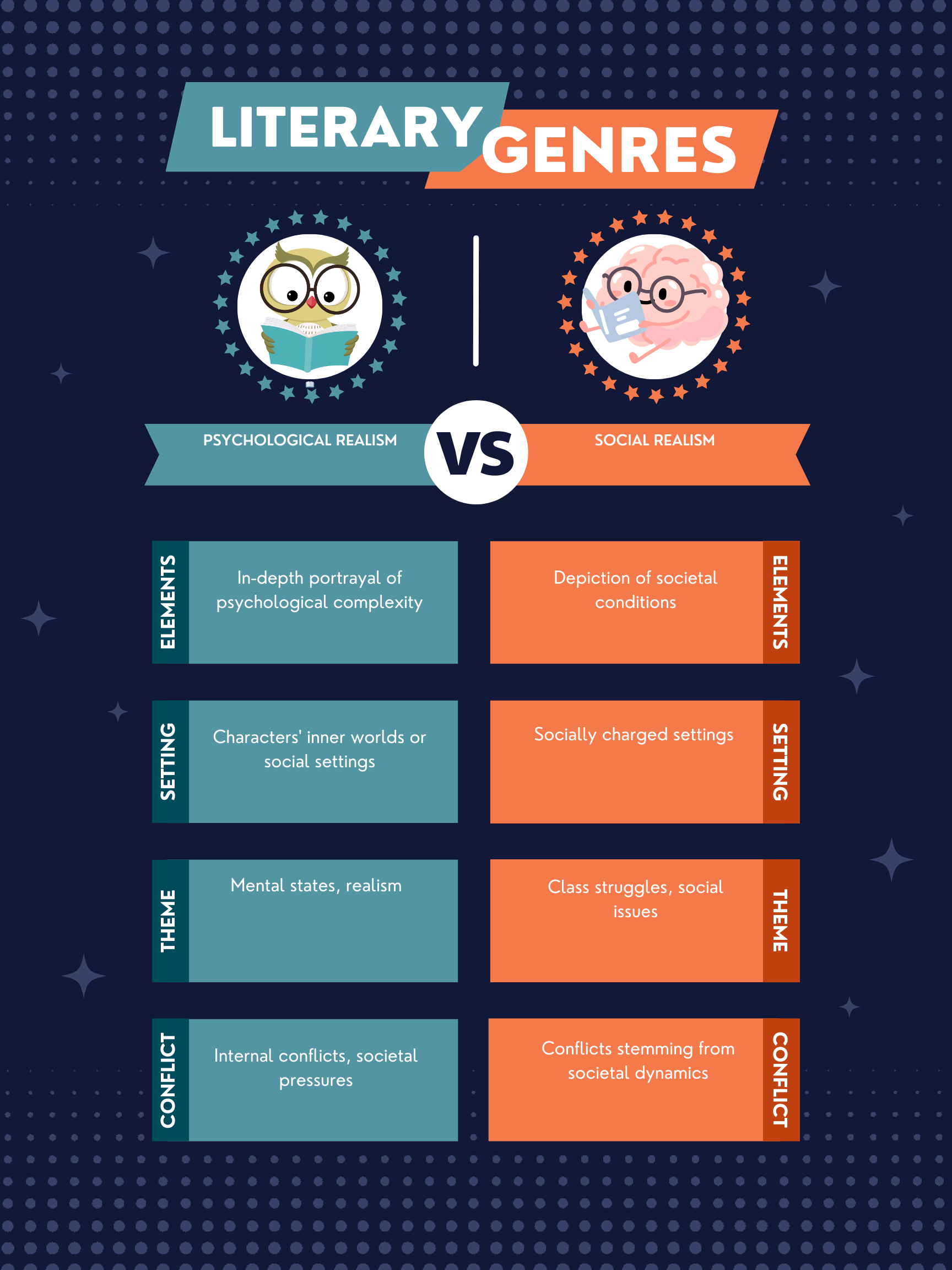Psychological Realism focuses on the internal thoughts, feelings, and struggles of characters; Social Realism emphasizes the depiction of everyday life and society’s ills, often critiquing social structures.
Psychological Realism
Psychological Realism is a literary device that dives deep into the inner workings of characters’ minds, exploring their thoughts, emotions, and motivations. This approach aims to present characters in a way that is true to life, reflecting the complexity of human psychology.
Example: Fyodor Dostoevsky’s Crime and Punishment is a prime example, delving into the protagonist Raskolnikov’s psychological turmoil and moral dilemmas following his decision to commit murder.
Social Realism
Social Realism, on the other hand, is concerned with depicting social, economic, and cultural conditions of life in a realistic manner. It often highlights issues such as poverty, class discrimination, and injustice, aiming to shed light on the struggles faced by ordinary people.
Example: John Steinbeck’s The Grapes of Wrath portrays the harsh realities faced by American families during the Great Depression, emphasizing the socioeconomic conditions of the era.
Summary
| Literary Device | Definition | Purpose | Usage | Relevant Examples |
|---|---|---|---|---|
| Psychological Realism | A literary approach focusing on characters’ internal thoughts, emotions, and motivations. | To explore the complexities of the human mind and present characters in a true-to-life manner. | Often used in novels that delve into character development and personal dilemmas. | Crime and Punishment by Fyodor Dostoevsky. |
| Social Realism | A narrative style that depicts everyday life and societal issues, critiquing social structures. | To raise awareness of and potentially inspire change regarding societal issues. | Found in works that address themes of poverty, class, and injustice. | The Grapes of Wrath by John Steinbeck. |
Writing Tips
When crafting narratives in either Psychological Realism or Social Realism, consider the following:
- For Psychological Realism: Develop deep, nuanced characters. Spend time understanding their backgrounds, motivations, and the psychological factors driving their actions. Let their complexities and contradictions be shown through their thoughts and behaviors.
- For Social Realism: Research the social issues you wish to explore. Authenticity is key, so ensure your depiction of societal conditions is informed and accurate. Incorporate real-life struggles, and consider showing the impact of broader social forces on individual lives.
FAQs
Can a novel incorporate both Psychological and Social Realism?
Yes, many novels blend both devices, exploring the psychological depth of characters within the context of their social environments.
How does Psychological Realism differ from character development?
While character development focuses on how a character changes over time, Psychological Realism emphasizes the realistic depiction of their mental and emotional state throughout the story.
Why is Social Realism important?
Social Realism brings attention to societal issues, encouraging readers to reflect on social injustices and the human condition, potentially inspiring empathy and change.
Exercise
Read the following paragraph and decide if it represents Psychological Realism or Social Realism:
“In the novel, the protagonist spends long nights pondering the morality of his actions against the backdrop of a society crumbling under economic pressure. His internal battle reflects not only his own guilt but also the desperation of those around him affected by poverty.”
Answer:
This paragraph incorporates elements of both Psychological Realism (the protagonist’s internal pondering of morality) and Social Realism (the mention of a society under economic pressure and poverty).
Other Device Comparisons You May Find Interesting
- Realism vs Naturalism: Explore how these literary movements strive for authenticity but differ in their philosophical underpinnings and methods of depicting reality.
- Modernism vs Postmodernism: Delve into the contrast between the structured, formal approach of Modernism and the eclectic, questioning nature of Postmodernism.
- Allegory vs Symbolism: Understand the differences between these two literary devices that use characters and imagery to convey deeper meanings.
- Stream of Consciousness vs Free Indirect Discourse: Compare these techniques for presenting characters’ thoughts and perspectives.
By distinguishing between Psychological Realism and Social Realism, writers and readers can gain a deeper appreciation for the diverse ways in which literature can mirror and critique the complexities of both the mind and society. 📚💡

